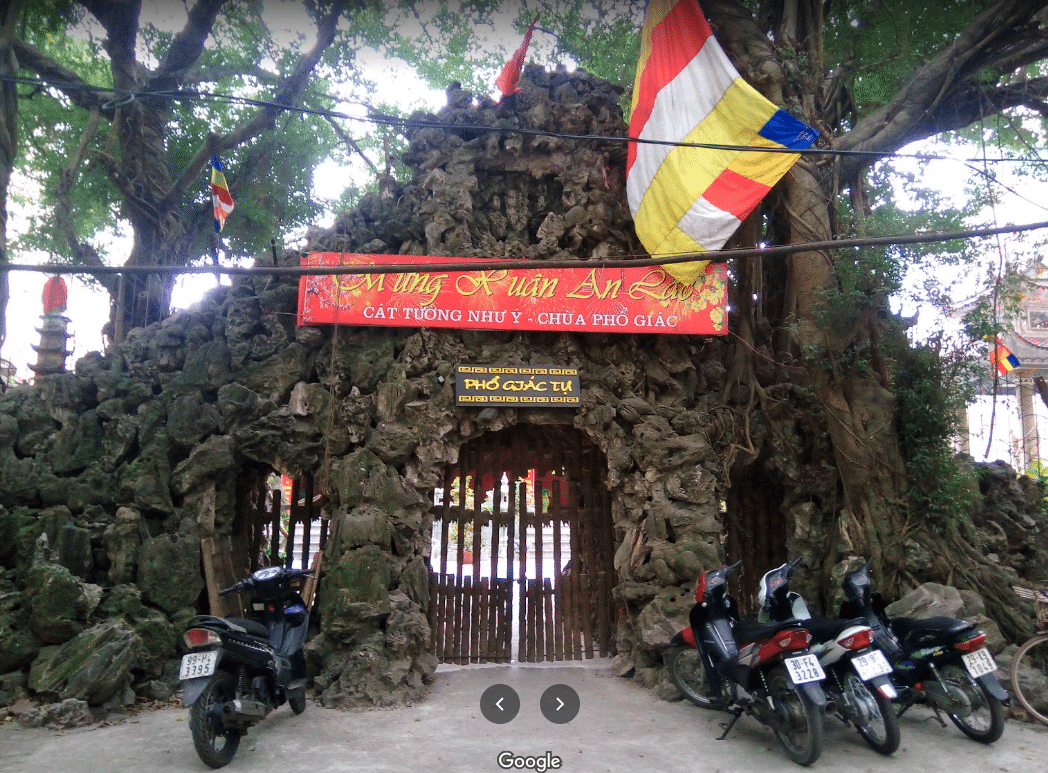Pho Giac Pagoda is also known as Tau Tuong Pagoda or Tau Elephant Pagoda, address: 80 Ngo Si Lien Street, Van Mieu Ward, Dong Da District, Hanoi. Initially (about 1770-1774 under Le Trung Hung), the pagoda was built in Phuc Co ward (in the middle of Nguyen Du street now). That place used to gather elephant ships of the Trinh army, including Duong Vo temple with Duong Vo bi Ky stele, built in August of the year of the Tiger, the 31st year of Canh Hung (1770), worshiping The three of them had the merit of training war elephants like the ancestor of the statue. In the Nguyen Dynasty, the temple was ruined, this stele was moved to Pho Giac pagoda.
After occupying Hanoi, the French colonialists took the land of the pagoda to build the governor’s office (now the headquarters of the City People’s Committee) and the Bank of Indochina, the pagoda had to be moved to the garden of the Thai Medicine Institute in Luong Su village (about below the street). Ngo Si Lien today). The pagoda keeps its old name and people are still used to calling it Tau pagoda. Duong Vo stele was also moved, still in the temple. Pho Giac Pagoda has the meaning of popularizing and enlightening Buddhism to Buddhists and people. In addition to worshiping Buddha and Mother Goddess, the temple also worships Phan Canh Diep, a good elephant trainer during the Le Trung Hung period.
Pho Giac Pagoda has been restored and repaired many times, the stele erected in 1856-1876 also clearly states this. A couple of parallel sentences embossed on the pylon indicate that the year of the Dog of the Dog in 1886 repainted the Buddha image, and the year of the Ox in 1889 repaired the interior, the front hall, the harem, and the Ancestral Church. In 1951, the pagoda was restored and rebuilt in 2014 to shape the architecture as it is today. On October 2, 1991, the Ministry of Culture and Information ranked the pagoda as a national historical, architectural and artistic relic.
Pho Giac Pagoda still has the old three-way gate built in the style of arched stone under the shadow of ancient trees, which looks quite beautiful and unique. This gate is not high and wide, but uses carpentry stones to form the image of a large lion kneeling in front of the Trinh lord’s palace in Thang Long citadel. The doors are assembled with round hewn wooden slats, simulating the shape of a bamboo tree. There is a theory that the above architecture implies that Pho Giac Pagoda is one of the largest mountain sects belonging to the Cao Dong Zen sect introduced to Vietnam in the 17th century, because the mountain symbolism is reminiscent of mountain monasticism which is associated with this faction.
Visitors go from the gate to the front yard and then step up to the high steps of the three treasures. The entrance hall consists of 7 compartments with two-story doors, 8 roofs with tiled roofs. The incense burner and the upper hall are also of the same type, connected to the front street to form the “Cong” shape. Outside, there is a porch and stone pillars around. There are also 3 steles and a pair of stone horses placed behind the harem. In the narrow courtyard outside the main temple porch, there are a few more semi-open-air altars
On both sides of the three-way gate, there are statues of elephants and horses. The Mother Church consists of 3 compartments, located on the right of the front yard, right behind a tomb tower, on the left side of the yard is another tomb tower and a 2-storey 8-roofed communal house, where the statue of Quan Am is located. The right side burns incense, the upper hall is the guest house and the Ancestral Church with 5 compartments, also has a porch and stone pillars, the left side is for accommodation. All buildings are plated on high ground.
Currently, in Pho Giac pagoda, there is a system of 37 round statues, including 20 statues in the Buddha hall, 11 statues in the Mother Church and 6 statues in the Tote Church. There is also a portrait of Phan Canh Diep and a divine genealogy book recording his merits in the harem, a stele talking about the medicine profession and the construction of the Y Mieu.
Among the antiques, there are 13 stone steles, 3 bronze bells, 1 pair of stone horses, altars, tablets, altars, altars, hammock doors and nearly 30 diaphragms, rich couplets in all aspects. The wooden part is decorated with patterns, Buddhist stories and themes of the four spirits and the four quarters. The pagoda still retains many precious worshiping objects made of bronze, wood, ceramics…
Source: Collected internet.
